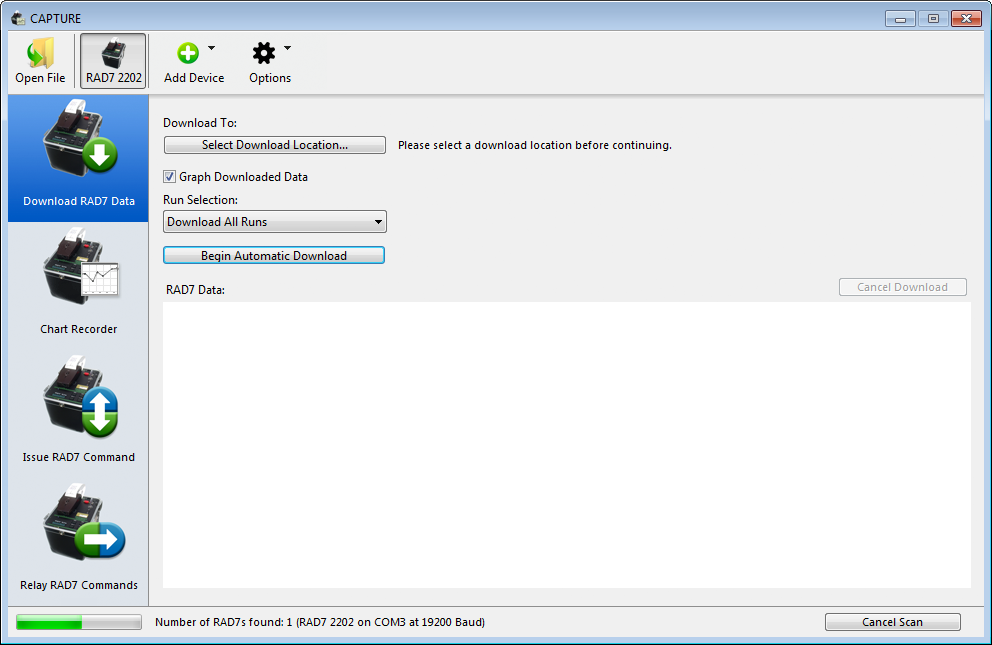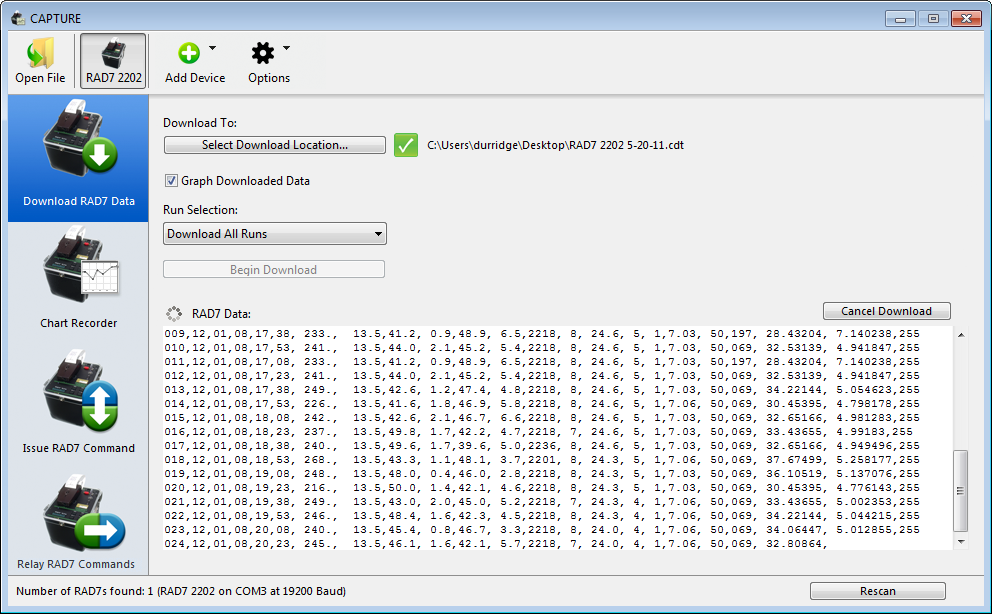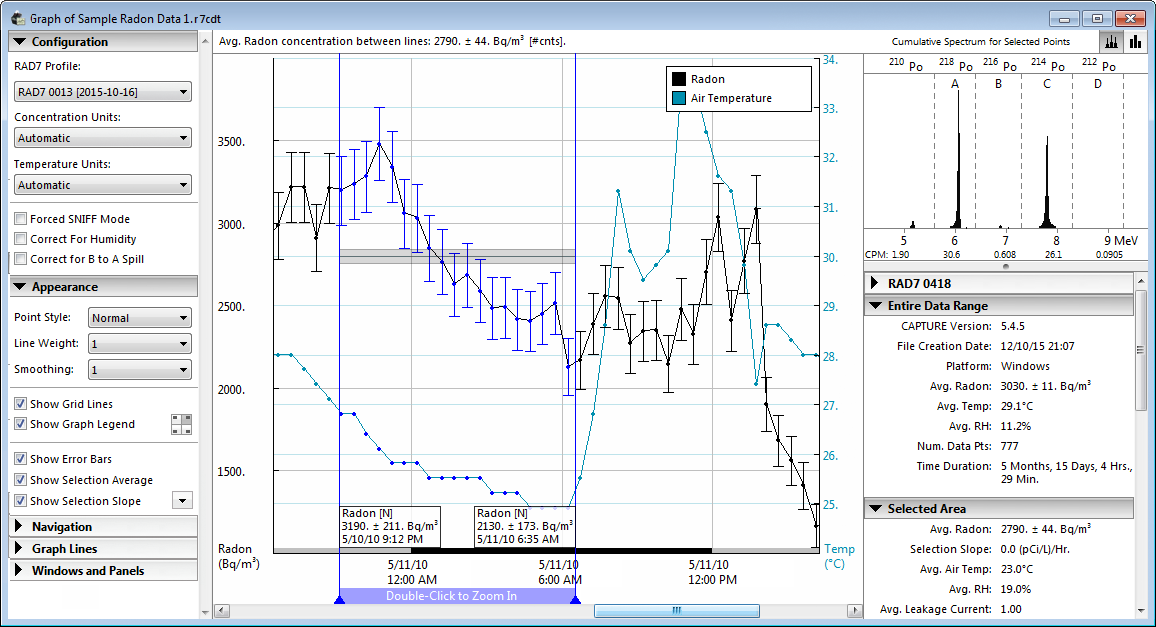

Basic CAPTURE Functionality |
|
|
This section will introduce the CAPTURE user interface and provide instructions on connecting a RAD7 to the computer, obtaining data from the RAD7, and displaying a data graph. |
Make sure the RAD7 contains several valid data records and that it is plugged into a stable power source and powered On. The included USB to Serial adapter should be used to connect the RAD7 to your computer. It is also necessary to install the appropriate driver software, which is also included. If your computer has a physical serial port, it is possible to instead use an RS232 DB9 female to female null modem cable to connect the RAD7 directly to your computer's serial port. For wireless RAD7 connectivity, a Bluetooth Serial adaptor may be used to facilitate communication, as explained in the Long Distance Connectivity section. DURRIDGE offers preconfigured Parani SD-1000 Serial to Bluetooth Adaptors as an optional RAD7 accessory. Figure 1 shows how to connect the RAD7 to a computer using two different kinds of USB to Serial adaptors: the StarTech adaptor (top), and the Keyspan adaptor (bottom). |
|
|
|
When CAPTURE starts up, the Main Window will appear. This window contains controls used for downloading RAD7 data and performing other RAD7 communication operations, as well as opening existing RAD7 data files
from disk. When the window first appears, some controls will be disabled. These controls become active only when a connected RAD7 has been detected. |
|
 Figure 2: Scanning for connected RAD7s to add them automatically.
Figure 2: Scanning for connected RAD7s to add them automatically.
|
If RADLINK is present on the RAD7, CAPTURE may detect the device automatically as the program launches. If it does not, click the Scan For RAD7s button at the lower right corner of the main CAPTURE window. (Automatic RAD7 detection can be enabled or disabled in CAPTURE's Preferences Window. The option is on by default.) When CAPTURE is scanning for RAD7s a progress bar will appear, and any detected RAD7s will be added to the window's tool bar, as shown in Figure 2, above. If RADLINK is not present, click the Add Device button in the toolbar, which is shown in Figure 3, below, and choose Add RAD7 from the menu that appears. The Connection Panel will appear, containing controls for specifying the Connection Type, Serial Port, and Baud Rate, as shown in Figure 4. The Connection Type pop-up menu should be set to "Serial Port". The other options are for connecting to a RAD7 at a remote location using a network connection. These options require additional configuration, and are discussed in the Long Distance RAD7 Communication section. (It is recommended that users first learn how to perform downloading operations via a direct serial port connection, before moving on to more advanced remote operations.) The Serial Port pop-up menu should be set to the name of the port to which the RAD7 has been connected. Finally, the Baud Rate pop-up menu should be set to the baud rate of the RAD7. For a RAD7 without RADLINK, this will always be 1200. Once the correct settings have been selected, click the Connect button. |


|
Note that it is possible to manually add a RAD7 even if it has RADLINK installed (though it may be more convenient to let CAPTURE detect it automatically using the Scan for RAD7s button.) If RADLINK is installed, the RAD7's baud rate may be checked and altered using the RAD7's keypad. To do this select the Special menu command on the keypad and press [ENTER], and then navigate to the SetBaud command and press [ENTER] again. Use the left and right arrow keys to choose the desired baud rate, and press [ENTER] a final time to confirm the selection. When downloading manually, whichever baud rate is chosen on the RAD7 must also be chosen in CAPTURE. If RADLINK is not installed, the baud rate can not be checked on the RAD7, but it can be assumed that the baud rate will always be 1200. |
Downloading the RAD7 memory to your computer makes it possible to graph, analyze, and share the RAD7 data, as well as preserve it against accidental erasure or corruption. It is recommended that the data be downloaded upon completion of each on-site test, or as frequently as is practical. Along the left side of CAPTURE's main window is a series of buttons connecting to panels used for performing various RAD7 communication operations. These include Download RAD7 Data, Chart Recorder, Issue RAD7 Command, and Relay RAD7 Commands. After CAPTURE has connected to a RAD7, a series of brief tests will be performed to determine which communication operations are possible. While the Download RAD7 Data panel will be available for all RAD7s, the other panels are only available for RADLINK-enabled RAD7s. Select the Download RAD7 Data panel if it is not already highlighted. A set of controls will appear for specifying the name and desired location of the downloaded RAD7 data, and whether to display the data in a graph. The Download RAD7 Data panel also includes a Run Selection pop-up menu, as shown in Figure 5, below. The Run Selection pop-up menu has four options: Download All Runs, Download Latest Run Only, Download Specific Run, and Download Range of Runs. If the RAD7 has the RADLINK software installed, the resulting RAD7 data file will contain supplementary information on thoron and run numbers, and the file name will use the .R7CDT extension. Files lacking this supplementary data use the R7RAW extension. While R7CDT files are somewhat larger on disk than R7RAW files, both are quite compact and storage capacity should not be a concern. |
|

|
After specifying the appropriate download parameters, click the Begin Download button. If the RAD7 has RADLINK, data will begin arriving almost immediately, as shown in Figure 6, below. Otherwise it will be necessary to start the RAD7 manually. To start the RAD7 manually, use the RAD7 keypad to choose Data, and then Com. Then key in the desired run number and press [ENTER]. You will have sixty seconds to complete this procedure before CAPTURE aborts the download due to an absence of incoming data. The download may be canceled at any point using the Cancel Download button. |
 Figure 6: A RAD7 data download operation in progress.
Figure 6: A RAD7 data download operation in progress.
|
As data records are received, they will fill the RAD7 Data text area at the bottom of the window as shown in Figure 6. When CAPTURE senses that the data retrieval process is complete, the acquired data will be saved to the specified location on disk. If the Graph Downloaded Data checkbox is checked, the Graph Window will appear, displaying the acquired data as shown in Figure 8, below. When the Graph Window opens, it may be necessary to specify Run Parameters. For most projects it will be appropriate to leave the run parameters set to their default settings, but if the radon data was collected with the use of certain DURRIDGE accessories such as the RAD AQUA, Water Probe, or Big Bottle System, then some configuration will be required. Choose Select All from the Edit Menu, and then choose Run Parameters... from the File Menu to choose the appropriate parameters. Refer to the Graph Configuration Section for more details. If CAPTURE senses that one or more incoming RAD7 Data records are problematic, the Errors Window will appear containing details on the problem. This is described in depth in the RAD7 Data Errors section. |
CAPTURE makes it easy to quickly download all of the raw data from each connected RAD7. Once the RAD7s have been discovered, the Download Data From All RAD7s command will become enabled in the Options menu located on the Main Window toolbar. |
|
|
 Figure 7: Downloading data from all connected RAD7s.
Figure 7: Downloading data from all connected RAD7s. |
The Graph Window displays radon concentration data across a timeline from
left to right, with periods of higher radon concentration stretching
further towards the top of the graph. In addition to radon, a graph may display thoron, temperature, and humidity data.
A multitude of controls are available for navigating the RAD7 Data graph.
These are discussed in the Graph Navigation section. |
|
